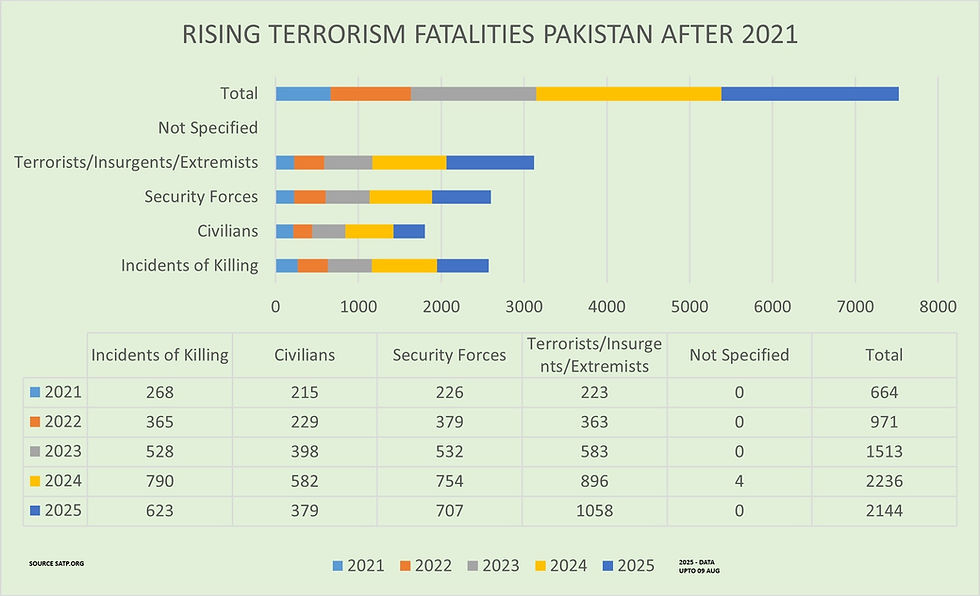No Space for Supporting Terrorism in a Nuclearised Environment
- rkbhonsle
- Oct 19
- 4 min read

Pak Army Chief Munir’s misreading of the contemporary nuclear theory and praxis in the Subcontinent is disastrous for his country.
Pakistan’s Chief of Army Staff (COAS) Field Marshal Asim Munir completely misconstrues the nuclear narrative claiming on October 18 there was “no space for war in a nuclearised environment.”
What the Army Chief failed to understand and so is the top brass of the country for decades is that there is no space for supporting terrorism in a nuclear environment facing India and Pakistan for the past two and a half decades.
Pakistan’s role in supporting terrorism in Jammu and Kashmir and rest of India is well recorded be it Mumbai 26/11 in 2008 or Pahalgam 22/4 in 2025.
While denial and deflection is Pakistan’s strategy in countering India’s pointed evidence on the role of the miliary in supporting terrorists of multiple hues and under differing garbs with a change of names from the Hizbul Mujahideen to the Lashkar e Taiyyaba and the Jaish E Mohammad to the most recent The Resistance Front [TRF] the country has acted under the belief that the nuclear umbrella will provide a shield preventing a conventional strike by India which has been the biggest worry for Pakistan.
However, with Operation Sindoor the targeted attacks on terrorist hubs inside Pakistan having shattered this belief which Prime Minister Narendra Modi called the “bluff”, it should be evident to Munir that nuclear shield does not guarantee safety and security from India’s strikes deep inside Pakistan.
The muscle flexing narrative of the Army Chief at a passing out parade at the Pakistan Military Academy (PMA) in Kakul has attempted to shield this stark reality that the so called ‘stability – instability paradox,’ as the protective nuclear cover for Pakistan’s ignominious support to terrorism against India has been effectively blown.
Asim Munir seemed to ironically accept that narrative is more significant than the reality as he told the young and impressionable cadets that, “Unfortunately, in the post-truth era in which we live, perceptions bear more weight than reality and half-truths spread faster than facts. Your strength will lie in thinking critically and discerning fact from fiction,” he said, urging them to not become “tools of disinformation”.
Little did the young cadets know that their Chief was spreading disinformation to pollute their young minds while obfuscating his own role as the Army Chief and the DG ISI in the past in supporting terrorism against India while remaining oblivious of the shifting sands of time on the nuclear front.
Behind India’s confidence of breaching the nuclear shield of Pakistan to sponsor terrorism is a a careful reading of the ‘full spectrum doctrine,’ [FSD] and the ‘four red lines,’ espoused by the Western adversary.
A recent issue of the Bulletin of Atomic Scientists highlights some of the critical facets of Pakistan’s nuclear doctrine.[1]
Summarised the FSD implies an arsenal of strategic, operational and tactical nuclear weapons to cover the whole of India with variable yield and numbers to respond to India’s declared policy of massive retaliation.
Pakistan hopes that the ‘counter-massive retaliation’ capability could prevent a decapacitating second strike by India.
The now retired Lt. Gen. Khalid Kidwai, a former head of Pakistan's Strategic Plans Division who continues to dominate Pakistan’s strategic planning and main proponent of the “full spectrum” has identified “horizontal” and “vertical” elements of the FSD in terms of the nascent nuclear “triad” encompassing the Army Strategic Force Command, the Naval Strategic Force Command, and the Air Force Strategic Command and thee three tiers of destructive yield—“strategic, operational, and tactical,” respectively —as well as a range of coverage in India, “from zero meters to 2750 kilometers.”
The FSD is designed to deter a conventional Indian operation under the “cold start” doctrine -shallow attacks on a wide frontage which were designed to be punitive in nature and yet prevent activating the nuclear trigger. The Cold Start has since been moth balled by India but Pakistan seems to believe that this is not so.
The Cold Start doctrine was presumed on the four red lines, articulated by Kidwai in 2002 - Spatial Threshold, Military Threshold, Economic Strangulation and Domestic Destabilization.
India’s unstated strategy for conduct of punitive strikes against Pakistan on the event of a terrorist attack takes into account these thresholds and operates far below these striking purely terrorist hubs be it in 2019 at Balakote or the attacks on Muridke and Bahawalpur apart from other targets in 2025. In turn the FSD is also effectively neutered.
To the prescient observer which obviously Pak Army Chief is not and continue to pose the façade of a bravado, there is adequate space for India to respond to a terrorist attack conventionally without triggering the nuclear threshold.
Aerospace power due to precision, standoff capability and lethality provides the answer.
That said the frequency of use of the ‘N’ word by leaders on both sides is completely unwarranted for the nuclear Armageddon can place the people of South Asia into a catastrophic situation.
There is adequate theoretical evidence to show that repeated use of a Word may turn out to be a self-fulfilling prophecy which in this case could be Doom for there are no winners in a nuclear exchange.
[1] Pakistan nuclear weapons, 2025
By Hans M. Kristensen, Matt Korda, Eliana Johns, Mackenzie Knight-Boyle | September 4, 2025. Available at https://thebulletin.org/premium/2025-09/pakistan-nuclear-weapons-2025/#:~:text=Pakistan%20does%20not%20have%20a%20No%20First%20Use%20policy%2C%E2%80%9D%20adding,of%20what%20this%20doctrine%20entails.



Comments